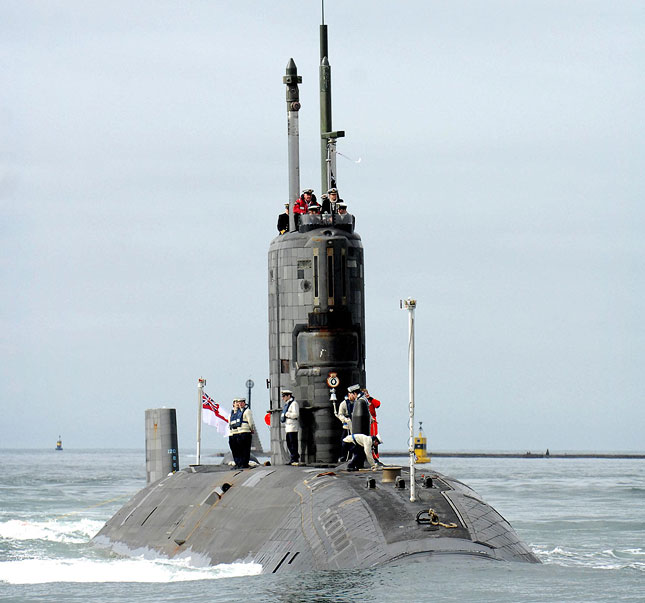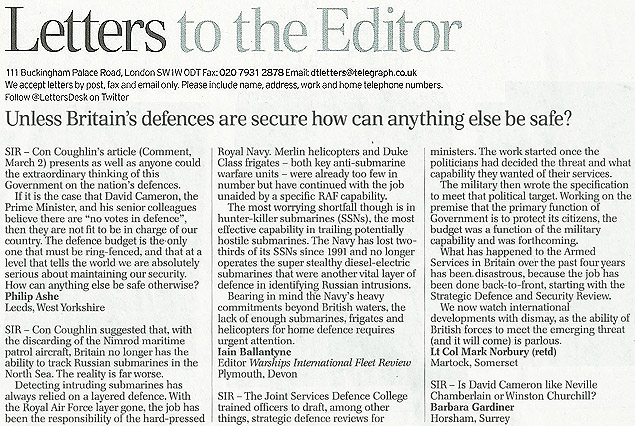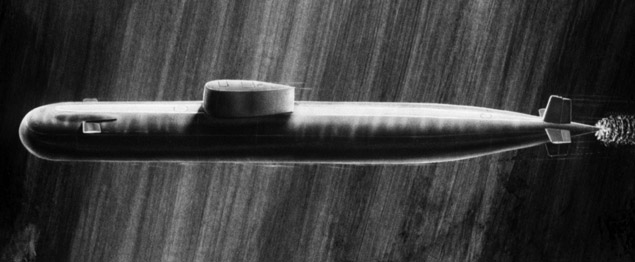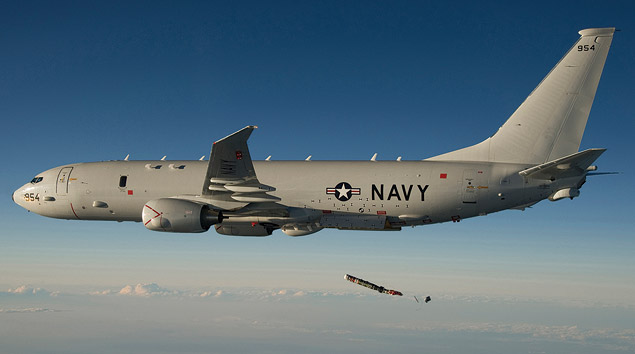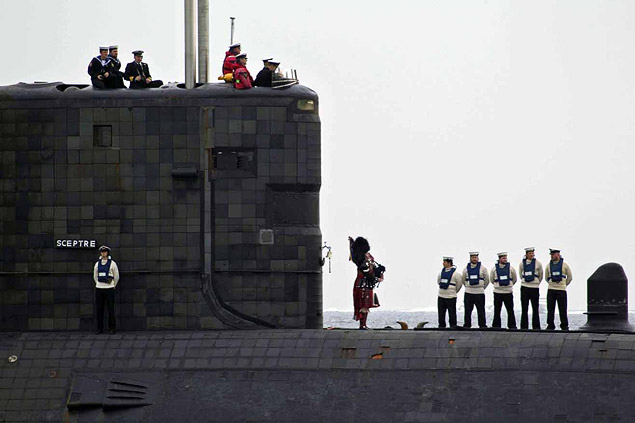Hunter-killer submarine’s ‘iceberg collision’ is a case of Déjà vu
During the previous Cold War it was easier to cover up collisions at sea between submarines, but now, across the battleground of social media and online news reporting, it is far harder to keep a lid on things. In fact, the actual truth now comes in way behind the devastating offensive weapons of on-line satire and mythmaking.
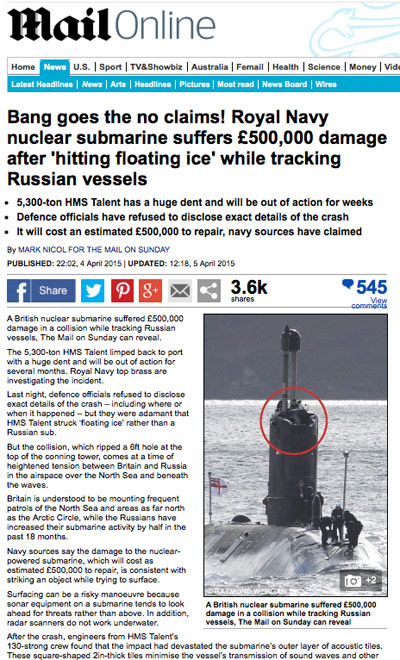 In the latest so-called submarine collision incident the British have come off looking somewhat pompous (and lacking credibility) while the Russians look good. Nobody is asking the latter to provide any hard proof on the other side of the story.
In the latest so-called submarine collision incident the British have come off looking somewhat pompous (and lacking credibility) while the Russians look good. Nobody is asking the latter to provide any hard proof on the other side of the story.
It all blew up when news organisations in the UK published reports about Trafalgar Class hunter-killer submarine (SSN) HMS Talent returning home not long ago with a severely crumpled fin. The Devonport-based vessel also suffered the misfortune of a photographer loitering on the nearby shore with a very high power lens on his camera.
The Daily Mail’s take on the submarine collision claim. Via Daily Mail web site.
The Daily Mail hedged its bets by splashing a headline suggesting Talent suffered £500,000 worth of damage due to ‘floating ice’ while tracking Russian naval vessels. Some experts have suggested the repair bill is likely to be far higher. Meanwhile, a less lurid (much shorter) yarn in The Daily Telegraph suggested ‘Surface wound: Sub has repairs.’
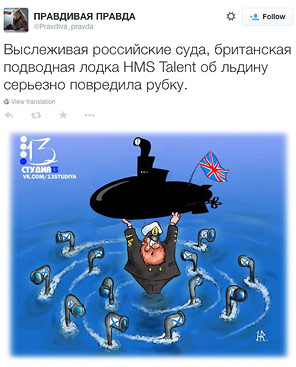 In Russia, Pravda had a fun time, publishing a cartoon showing Talent being held aloft by a sheepish looking, rather portly Royal Navy officer surrounded by circling Russian Navy submarine periscopes.
In Russia, Pravda had a fun time, publishing a cartoon showing Talent being held aloft by a sheepish looking, rather portly Royal Navy officer surrounded by circling Russian Navy submarine periscopes.
Score one for the Kremlin? One Russian Internet wag retweeted the Pravda cartoon while another mickey-taking twitterer scoffed: ‘The crew of " ice floes " was not injured.’ Other Russian tweets suggested the ‘ice floe’s’ operators were to receive medals.
Oh what fun they had: Russian social media reaction to the Talent ‘ice collision’ incident. Via Sputnik International.
And that is where the problem lies because, regardless of whether or not Talent really did crunch her fin on a Russian surface vessel (while taking a sneaky underwater look), have a brush with another submarine or, in fact, suffer a collision with ice, the UK Ministry of Defence has a history of covering things up by suggesting that it was ice what done it. This time, on being quizzed by Russian media, a Ministry of Defence spokesperson reportedly observed rather haughtily: “where journalists found their information, it hardly corresponds with reality.”
Unidentified defence officials had earlier been ‘adamant’ when quizzed by the Daily Mail about Talent making contact with ‘floating ice’ rather than a Russian submarine. They would not say where or when the incident happened.
It would have been better to make no comment at all or just say the incident was caused ‘during training’. Another alternative would have been to provide the full story from the British side. The claim of ‘hitting ice’ (even if true in this case) is the submarine equivalent of crying wolf too many times. It has the opposite effect to that which is intended, because it has become a euphemism for a collision between two submarines. Sneering comments doubting the veracity of journalists’ work only stoke the fires, especially when there is a photograph to base the story on.
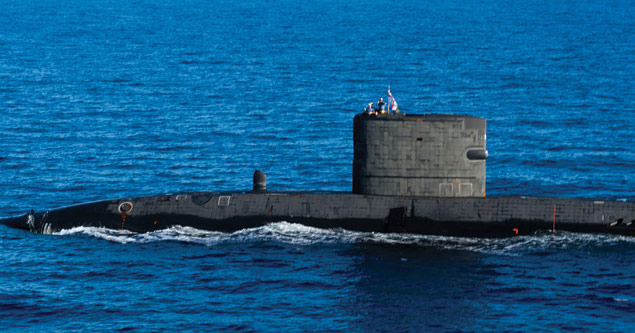
The hard-working British hunter-killer submarine HMS Talent on a deployment in the warmer waters East of Suez, more than a year before her alleged collision with ‘ice’. Photo: US Navy.
The MoD was less than amused that my book ‘Hunter Killers’ included insider-based details of the two most serious incidents involving British submarines and ‘ice’ – in reality Soviet Navy nuclear submarines – namely HMS Warspite’s October 1968 coming together with an Echo II in the Barents Sea and HMS Sceptre’s scrape with a Delta Class ballistic missile boat (SSBN) in May 1981, also in northern waters.
In both cases, at the time, while photos like those of Talent with her bashed in fin were not published, the newspapers did carry stories about collisions with ice (which were over subsequent years debunked by sources in the West and Russia including people who were there). In both Warspite and Sceptre’s case there were attempts to make the damage less obvious before they were brought home to Barrow (Warspite) and Devonport (Sceptre) for major repairs. No such measures appeared to have been taken when Talent came back into Plymouth and cruised through the very public arena of the Sound on her way to Devonport. This might tend to suggest the culprit in this case was actually ice – nothing to hide here folks! Or was it just a double bluff?
Beyond all the points scoring of today on the social and news media battleground, in which the Kremlin deploys many different means to convey its propaganda and also spin stories to its advantage, whatever caused Talent’s damage must have been pretty scary for those involved. Both the submariners and the submarine will need careful rebuilding and handling from now on.
Such incidents were certainly extremely stressful for submariners of the old Cold War, engaged as they were in a deadly serious game on the most important front of that confrontation. Nuclear-powered submarines, some of them carrying nuclear weapons too, were trailing each other in very close proximity. The stakes were incredibly high for both the men and their nations.
Back in an era where MPs seemed to be more grown up about the topics they debated, there were numerous questions asked in Parliament about the potential dangers of a nuclear incident arising from such an accidental clash.
The fact that the submariners’ job was dangerous was certainly no secret and MPs on several occasions in the 1980s expressed concern the risks were becoming too great. A 1986 episode involving the British submarine HMS Splendid made a big splash in UK newspapers, provoking further heated discussion in Parliament. On Christmas Eve, the Swiftsure Class boat had encountered a Soviet Typhoon SSBN in the Barents Sea, momentarily making physical contact, with the towed array sonar of the British vessel allegedly torn away.
In 2015, with Parliament broken up for the General Election, there will be no similar questions asked in the House of Commons. Knowledge of naval affairs is, anyway, very thin on the ground and hard questions are unlikely to be asked due to a shortage of what could be termed ‘naval intellect’ (or front line maritime experience) among MPs. As a former Secretary of State for Defence termed it recently ‘there are no votes in defence’ so the majority of politicians in the UK are just not interested. They should be, for it is vitally important today’s submariners get the backing they need and that their dangerous missions carry on. The alternative is to allow the Russians to continue exploiting UK and NATO capability gaps at sea. Gaps created by the unwise defence cuts of British politicians (who seem keen to make even more in the next Parliament).
Let’s not forget that back in the old Cold War it wasn’t just the British and Russians who jousted with each other – and sometimes suffered a collision – for the Americans were also in there. Like the Russians, but unlike the British, the Americans suffered actual losses of nuclear vessels (the Soviets several and the USA two, but none of them in collision with opposition submarines).
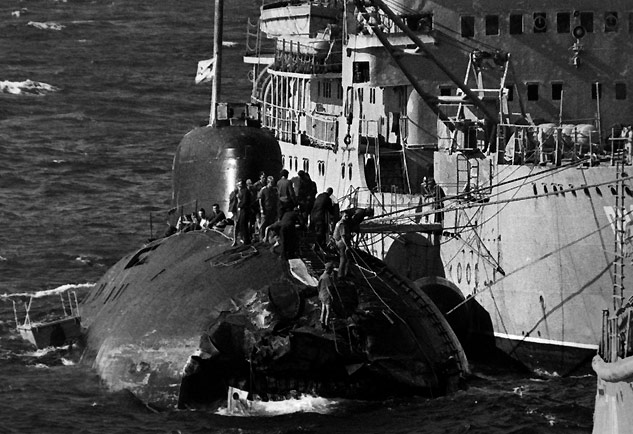
During the Cold War it happened to the Russians too: Starboard bow view of a badly damaged Soviet Victor Class nuclear-powered submarine while alongside an auxiliary tender. The submarine is believed to have collided with a merchant vessel. Photo: US DoD.
There is no such thing as a non-serious collision between dived submarines but figures for the exact number of undersea bumps are hard to come by. In the mid-1970s a report to Congress by the US Navy admitted to nine such incidents in waters close to the Soviet Union between 1965 and 1975. For their part the Russians confessed to seven crashes involving their submarines and those of the US Navy in the period 1968 – 1987. The British won’t officially admit to any.
Anyway, if it really was a collision between submarines, somebody ought to ask the Russians how they allowed a British hunter-killer to get that close to them? It shows pretty poor Anti-Submarine Warfare (ASW) skills on the Russian side that the first they knew of a Royal Navy SSN being on their tail was the crunch of it hitting their vessel. Never mind Talent, what scale of damage has been caused to the Russian submarine (or even surface ship) allegedly involved?
Cockiness on social media and via partisan news outlets is one thing, but the truth remains that American, if not British, submarines are potentially out there silently and stealthily monitoring every move the Russians make.
And in nearly all cases the Kremlin’s boats will have no idea they are there.
Or perhaps it was ice, after all and the Russian Navy has nothing to worry about?
The main question that should be posed in the UK today, with one of its few operational SSNs out of commission due to a damaged fin, is: When are force levels are going to be raised again (to meet the revived Russian threat)?
At the height of the Cold War the Royal Navy operated four ballistic missile submarines (SSBNs), nine hunter-killers and 18 diesels in front line service, a total of 31 submarines of all kinds. Today there are still four SSBNs, but no diesels and a nominal seven SSNs (though in reality there are probably only three ready for world-wide operations, if you’re lucky).
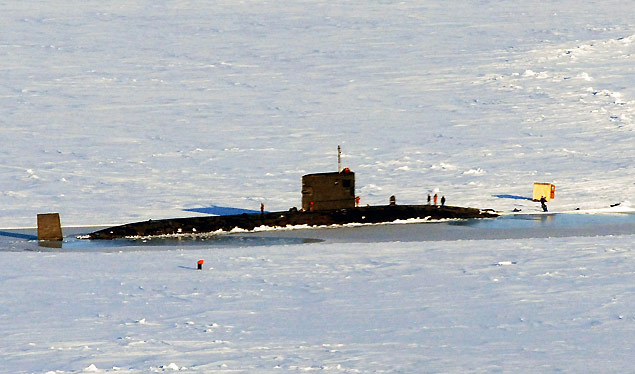
The real deal: A Royal Navy nuclear-powered submarine of the same type as HMS Talent operating in the Arctic amid the ice in 2007. Photo: US Navy.
Regardless of how capable a new Astute Class submarine is, it can only ever be in one place at a time. Closing with the opposition – ready to take assertive action if needed – requires operations in the same patch of sea. Or is the UK going to be forced into an entirely passive role due to its lack of units? Will it let the threat come knocking on its front door, rather than trail the potential foe and deter the danger at a safer distance, in the Far North? That would be a reversal of the forward deployed, aggressive policy that won the Cold War and a fatal error with tough customers like the Russians. Give them an inch and they will take the whole territory.
Regardless of whether or not it was ice that caused Talent’s damage, there are now so few British submarines that any lack of availability severely affects NATO and the UK’s ability to defend itself against increasingly assertive Russian behaviour at sea. That is a cold hard fact. Somebody in whatever government comes to power next month (May) needs to get to grips with it, or abdicate rule of the northern oceans, and possibly waters around the UK, to the Kremlin.
To read the exciting inside story of collisions between submarines, and many other dramatic episodes across the span of the Cold War under the sea, buy ‘Hunter Killers’ by Iain Ballantyne (Orion Books, £10.99, paperback). It is available direct from the publisher or via Amazon and other retailers.


